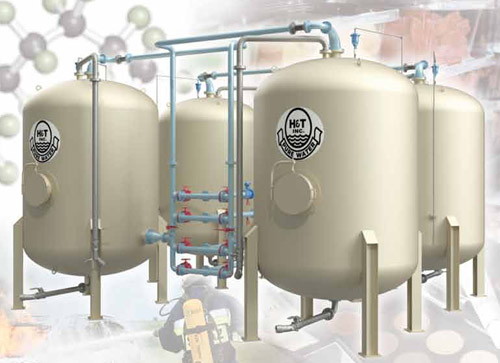Advanced Methods for Effective PFAS Contamination Removal
The relentless challenge of PFAS contamination demands the exploration of innovative elimination techniques that can effectively attend to these damaging substances. Ingenious innovations, such as innovative oxidation procedures and various adsorption methods, have arised as promising solutions in mitigating PFAS from impacted atmospheres.
Recognizing PFAS Residences
Although per- and polyfluoroalkyl compounds (PFAS) have actually been extensively made use of in different commercial and customer items as a result of their unique properties, their determination in the atmosphere positions substantial obstacles to public wellness and safety. PFAS are a team of synthetic chemicals characterized by a carbon-fluorine bond, among the greatest chemical bonds recognized, which adds to their outstanding stability and resistance to degradation. This security allows PFAS to gather in the atmosphere and living microorganisms, causing potential damaging health and wellness results.
These same homes contribute to their environmental determination, as PFAS do not conveniently damage down via natural processes. Understanding the chemical residential or commercial properties of PFAS is necessary for creating reliable strategies to manage and alleviate their ecological effect.
Cutting-edge Remediation Technologies
The persistence of PFAS in the environment has actually stimulated the growth of innovative remediation innovations aimed at successfully getting rid of these contaminants from impacted environments. Amongst the most encouraging techniques are innovative oxidation processes (AOPs), which utilize powerful oxidants to break down PFAS substances right into much less unsafe substances. AOPs can be customized to target details PFAS structures, enhancing their effectiveness.
One more arising modern technology is using adsorption media, such as turned on carbon and ion exchange resins, which can selectively capture PFAS from polluted water. These products have revealed substantial removal efficiencies, although periodic substitute and regeneration are necessary to maintain efficiency.
Membrane layer filtering methods, including reverse osmosis and nanofiltration, are also gaining grip in PFAS removal. These approaches can properly separate PFAS from water, offering a practical solution for dealing with contaminated sources. In addition, thermal therapy approaches, such as incineration, can break down PFAS into non-toxic results, though they need cautious administration to manage discharges.
Collectively, these innovative removal innovations represent substantial innovations in the ongoing fight against PFAS contamination, providing numerous methods to restore afflicted environments and protect public wellness.

Bioremediation Strategies
Bioremediation techniques supply a promising strategy to dealing with PFAS contamination by utilizing the natural abilities of microorganisms to degrade these relentless compounds (m270 waste management). This approach includes the use of microorganisms, fungi, and various other microbes that can metabolize or change PFAS substances right into less harmful by-products
Current innovations in molecular biology and ecological microbiology have boosted our understanding of microbial communities and their prospective roles in PFAS deterioration. Researchers are actively discovering certain strains of germs, such as Pseudomonas and Bacillus, which have actually demonstrated the capacity to break down particular PFAS compounds.
Sitting bioremediation techniques, where bacteria are stimulated directly go to my blog in polluted atmospheres, can be particularly reliable. This technique typically involves the application of nutrients or electron benefactors to promote microbial growth and task. Furthermore, ex lover situ methods, such as bioreactors, enable controlled conditions that can maximize deterioration prices.
In spite of the promise of bioremediation, obstacles continue to be, including the complex nature of PFAS compounds and the demand for considerable area testing - m270 waste management. Proceeded r & d will certainly be critical to improve these strategies and analyze their efficiency in diverse environmental contexts
Adsorption and Filtration Techniques
Resolving PFAS contamination often involves employing adsorption and filtering approaches, which are made to get rid of these persistent chemicals from water and dirt. Among the different techniques, triggered carbon adsorption is extensively utilized as a result of its high surface and porosity, making it possible for reliable trapping of PFAS molecules. Granular turned on carbon (GAC) systems are specifically preferred for treating large volumes of contaminated water, while powdered activated carbon (PAC) can be used for smaller-scale applications.
Ion exchange materials additionally reveal assurance in PFAS elimination, working by trading PFAS ions with less hazardous ions in the water. This method has shown performance in focusing PFAS substances, promoting their subsequent elimination. In addition, membrane layer purification methods, such as reverse osmosis and nanofiltration, operate by utilizing semi-permeable membrane layers to different PFAS from water, properly lowering their focus.
While these techniques work, they must be carefully selected based upon the details PFAS substances existing and the environmental context. Continual innovations in materials scientific research and design are bring about the development of unique adsorbents click here now and filtration systems that improve elimination efficiencies and decrease operational prices, consequently enhancing overall removal initiatives.
Regulatory and Policy Factors To Consider
How can efficient regulatory frameworks boost the management of PFAS contamination? Detailed plans are necessary to ensure a collaborated and durable reaction to the difficulties posed by per- and polyfluoroalkyl compounds (PFAS) Laws can establish clear guidelines for surveillance, reporting, and remediating PFAS-contaminated sites, promoting accountability amongst sectors and public entities. (m270 waste management)

Additionally, monetary motivations and grants can be incorporated into policies to urge the fostering of innovative go to this web-site remediation modern technologies. Policymakers should also focus on study and development, guaranteeing that arising approaches for PFAS elimination are validated and executed properly.
In addition, public awareness and engagement are important parts of any regulatory technique, equipping areas to support for their wellness and safety. Ultimately, a well-structured regulatory atmosphere will not just boost the management of PFAS contamination however likewise advertise lasting techniques that protect future generations.
Conclusion
In summary, the complexity of PFAS contamination requires the adoption of advanced remediation methods. Proceeded research study and growth in this area remain critical to resolving the difficulties posed by PFAS contamination.